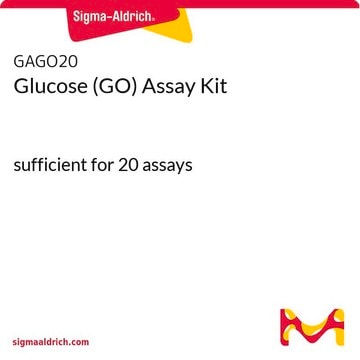The supplier advises that they have not yet validated any lysis buffers for use with cell samples in conjunction with this kit. Additionally, they recommend using an untreated, clear, flat-bottom plate for colorimetric measurements. Therefore, it would be preferable to transfer the samples to such a plate for running the assay.
MAK317
Sorbitol Dehydrogenase Assay Kit
sufficient for 100 colorimetric tests
Scegli un formato
About This Item
Prodotti consigliati
Metodo di rivelazione
colorimetric
Malattie correlate
endocrinological disorders, diabetes; gastrointestinal diseases
Temperatura di conservazione
−20°C
Categorie correlate
Descrizione generale
Caratteristiche e vantaggi
Compatibilità
Principio
Avvertenze
Warning
Indicazioni di pericolo
Consigli di prudenza
Classi di pericolo
Eye Irrit. 2 - Flam. Liq. 3 - Met. Corr. 1 - Skin Irrit. 2 - STOT SE 3
Organi bersaglio
Respiratory system
Codice della classe di stoccaggio
3 - Flammable liquids
Punto d’infiammabilità (°F)
75.2 °F - closed cup
Punto d’infiammabilità (°C)
24 °C - closed cup
Scegli una delle versioni più recenti:
Certificati d'analisi (COA)
It looks like we've run into a problem, but you can still download Certificates of Analysis from our Documenti section.
Se ti serve aiuto, non esitare a contattarci Servizio Clienti
Possiedi già questo prodotto?
I documenti relativi ai prodotti acquistati recentemente sono disponibili nell’Archivio dei documenti.
-
What are the recommended methods for homogenizing or lysing cells in a 96-well plate for the MAK317 Sorbitol Dehydrogenase assay kit? The manual advises against using proteolytic enzymes and suggests using a rubber policeman, which is not suitable for a 96-well plate. Are there any recommendations for a mild lysing buffer with minimal impact on the assay outcome? Additionally, is it possible and recommended to run the assay in the same 96-well plate, or is transferring the samples to a new plate necessary?
1 answer-
Helpful?
-
Active Filters
Il team dei nostri ricercatori vanta grande esperienza in tutte le aree della ricerca quali Life Science, scienza dei materiali, sintesi chimica, cromatografia, discipline analitiche, ecc..
Contatta l'Assistenza Tecnica.







